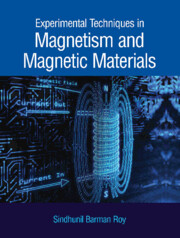Book contents
- Frontmatter
- Dedication
- Contents
- Preface
- I Introduction to Magnetism and Magnetic Materials
- II Basic Phenomenology of Magnetism
- III Experimental Techniques in Magnetism
- Appendix A Magnetic Fields and Their Generation
- Appendix B Units in Magnetism
- Appendix C Demagnetization Field and Demagnetization Factor
- Index
Preface
Published online by Cambridge University Press: 27 October 2022
- Frontmatter
- Dedication
- Contents
- Preface
- I Introduction to Magnetism and Magnetic Materials
- II Basic Phenomenology of Magnetism
- III Experimental Techniques in Magnetism
- Appendix A Magnetic Fields and Their Generation
- Appendix B Units in Magnetism
- Appendix C Demagnetization Field and Demagnetization Factor
- Index
Summary
Magnetism and magnetic materials have been subjects of considerable interest for more than 3000 years, going back to ancient times. In modern times, myriad are the applications of magnetism and magnetic materials ranging from generation of electrical power to communications and information storage. Magnetic materials are absolutely indispensable in modern technology, and the intensity and importance of their applications are reflected in the multi-billion dollar market for magnetic materials in three broad areas: permanent magnets, soft magnets, and the magnetic recording medium. Continuous evolution in the field of magnetic materials has not, however, remained confined only to these well-identified areas. It is now well recognized that fresh applications are possible through the coupling of magnetism with other physical properties of materials such as magneto-thermal, magneto-elastic, magneto-optic, and magneto-electrical couplings. Newer classes of magnetic materials are being discovered with interesting new functions stimulating further growth of newer technology in various areas including information technology, wireless communication, microelectronics, biotechnology, and such like.
Against this backdrop, it is natural that the subject of magnetism finds a prominent place in solid state/condensed matter physics textbooks taught in the advanced undergraduate and postgraduate courses at universities all over the world. However, this coverage is mostly confined to a basic understanding of the phenomenon of magnetism as one of the physical properties of solid materials within the general framework of quantum mechanics. Detailed theoretical exposition of the subject is left to the specialized books on magnetism, and there are not too many of such books. Unlike high energy and particle physics, magnetism with its huge potential in technological applications is mostly an experimental science, where experimental techniques and related instruments play a very crucial role. The quantum many-body theories of magnetism (and for that matter condensed matter physics in general) are continuously evolving to explain the classes of emerging phenomena being discovered through experimental work on magnetic materials (and other classes of condensed matter). It is experimentation which is leading the field in the case of condensed matter/magnetism rather than theory as in the case of high energy and particle physics.
In the area of high energy and particle physics, the students are at least aware of the necessary theoretical techniques and the relevant experimental methods before they enter the research field at the Ph.D. level.
- Type
- Chapter
- Information
- Experimental Techniques in Magnetism and Magnetic Materials , pp. xiii - xviPublisher: Cambridge University PressPrint publication year: 2023

